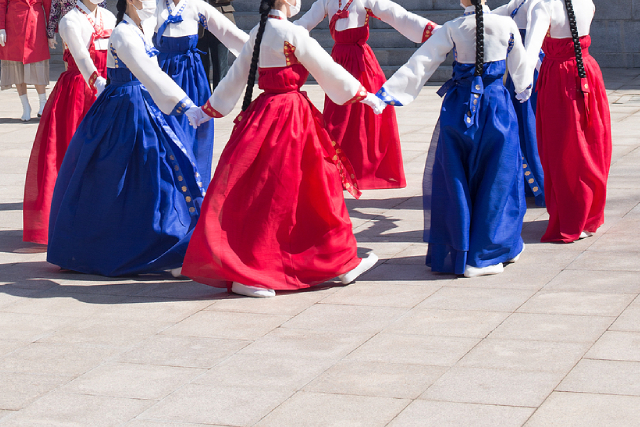While South Korean fashion has gained immense worldwide popularity over the years, those clothes are a far cry from what was once the traditional costume of Korea – the hanbok. Today, It is only worn on special occasions or anniversaries. Most Koreans do, however, have a hanbok on hand for formal occasions since it is a ceremonial outfit.
The first iteration of the hanbok was lovely in its own right, but the style has gradually evolved over the years. Hanbok’s beautiful shape and brilliant colours, which have significantly influenced the present fashion industry, are its essential features. It is gradually undergoing a revolution due to the changing fabrics, colours, and features that reflect the most recent style. Several budding hanbok designers have modified hanbok for everyday use, giving it a distinctly modern feel while still maintaining traditional aspects at its core.
What does it look like?
The chima (치마: skirt) and jeogori (저고리) for ladies, as well as the baji (바지: pants) and jeogori for males, make up the hanbok’s basic construction. The hanbok has a distinctive and remarkable feature that distinguishes it from other traditional costumes: when worn combined, the narrow top and wide bottom form a shape like a bell.
The baerae (the curving bottom line made by the jeogori’s sleeves) and the tidy lines of the dongjeong (동정) (the white pleated lining of the jeogori’s collar) of the hanbok are two examples of how the traditional Korean aesthetic is represented.
The hanbok first looks flat, but when worn, it takes on dimension and even lends the wearer grace since the broad and flexible skirt conceals the wearer’s lower body movements, giving the impression that they are floating in mid-air.
History
Over the course of its over thousand-year history, many materials have been used to create the hanbok. In reality, modern designers are still experimenting with various sorts of materials for their works.
However, historically, the hanbok’s fabric has served as a symbol of the wearer’s social status. In order to emphasise their power and authority, those born into the monarchy wore hanbok manufactured from the best fabrics, such as silk and satin. The same is true for dignitaries and high-ranking officials. In contrast, the hanbok worn by the common people were mostly made of hemp and cotton and gave away their humble origins.
The hanbok’s colours were also crucial in determining the wearer’s personality and social standing.
The common people donned hanbok of light and rustic colours, which can also be linked to the materials used to construct their modest hanbok. In contrast, those representing royalty or nobility wore hanbok dyed with vibrant colours.
The hanbok today
Hanboks are ceremonial clothes worn on special occasions or during Korean holidays by present-day Koreans. Children don hanbok for their first birthday, while adults wear it at important family ceremonies like weddings and funerals.
Despite the fact that hanbok is now exclusively worn ceremonially during traditional holidays, Koreans still appreciate them very much. People are increasingly donning fashionable hanbok that has been altered to be worn on a daily basis, and many like going out in hanbok after renting one of these from hanbok rental stores.
Conclusion
The hanbok is just another aspect of Korean history that the world is enamoured with. It is an essential part of history that has evolved over the years for the modern population to be still able to partake in it gladly.
If you’re interested in immersing yourself in this aspect of Korean culture, why not learn the language to better aid in your efforts? Sejong offers premium Korean language courses in Singapore taught by native speakers for those who want to gain deeper insight into the history and heritage of Korea. Contact us today to learn more!


